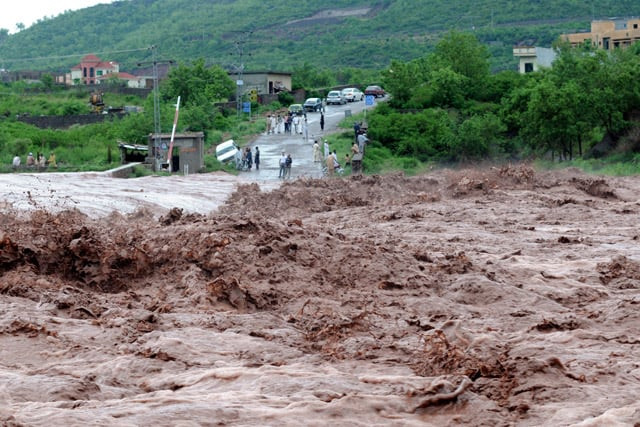These are not Pakistan’s worst floods
The devastation could have been contained had flood-prevention projects been put in place, experts say.

These are not Pakistan’s worst floods
The government claims that nothing could have prevented the floods that have killed more than 1,600 people and made over a million people homeless.
“These are not the country’s worst floods,” stresses irrigation expert Idrees Rajput, also a former member of the Sindh government. “Water levels in Sindh rose to similar high floods in 1992 and 1976 but the impact was not as huge. This time, flooding has been exacerbated only due to decades of government corruption and neglect.”
Pakistan has earlier braved floods in 1973 and 1976, following which the Federal Flood Commission (FFC) was established in 1977. The commission operates under the water and power ministry and was set up to integrate flood management on a country-wide basis, especially relating to the Indus River System. Before the FFC, provincial governments would plan and execute their own flood-protection projects.
Irrigation experts, however, believe that the Federal Flood Commission (FFC), in tandem with provincial irrigation departments, misused funds and poorly managed flood-prevention projects.
“All these years, the FFC has approved and executed water control projects only on paper,” says irrigation expert Arshad H Abbasi. “They were never there to monitor the work on the ground or to hold provinces accountable for work done.” According to official documents available with The Express Tribune, the FFC has “successfully prepared and executed” three National Flood Protection Plans (NFPP) worth Rs87.8 billion since 1978. A fourth plan is still under implementation. Among other flood-prevention projects, these plans included emergent flood schemes, such as building embankments and spurs and improving the flood forecast and meteorological system. The projects were mostly funded through foreign loans from the Asian Development Bank, the International Development Association-World Bank and German financial organisation KFW. Japan had made an additional grant of Rs348 million.
According to the FFC, the projects were executed in all the provinces, the Federally Administered Tribal Areas (Fata), Gilgit-Baltistan, and Azad Jammu and Kashmir. A list of projects “completed” in 2007-08 shows that 17 projects were executed in Balochistan, 11 in Punjab, nine in Khyber-Pakhtunkhwa, nine in Fata, six in Sindh, and five in Gilgit-Baltistan.
In Khyber-Pakhtunkhwa’s worst-hit districts, Nowshera and Charsadda, the FFC claims that it executed projects worth Rs27.3 million in 2007-08 and Rs52 million in 2008-09, which were 92 per cent complete [before the floods]. While documentation is officially complete, the projects are yet to be identified by locals on the ground. The Punjab chief minister had recently inspected bogus projects in South Punjab but the government did not still chose to stay silent over the FFC’s criminal negligence.
FFC Chairperson Zarar Aslam told The Express Tribune that the commission is not an executing body. “The FFC is constantly alleged of corruption but we are not an executing body. Our role is to facilitate the provinces, approve their schemes and provide funds to the respective irrigation department officials in each province.”
Aslam said that the commission had received Rs25 billion for flood mitigation, excluding the Rs740 million that were allocated to the FFC in the present year’s budget. This lack of funds, he said, makes accountability difficult as the commission had no budget for monitoring the implementation phase. “One needs to ask the provinces where all the money went. They are responsible for executing approved schemes and maintaining their embankments and bunds,” he said.
In a recent report by corruption watchdog Transparency International Pakistan, the chairperson was accused of misusing about 60 to 70 per cent of the budget. The amount was meant to be allocated to provinces. Zarar rubbishes the allegations. “If this were the case, then in 34 years, the FFC could not have managed to build embankments along 6,796 kilometres of the river and 1,410 spurs across the country.”
But building them is not enough, say experts. The structures have to be looked after on a regular basis, especially during the monsoon season when floods can be expected. Some structures, add experts, have not been upgraded since 1929.
“These were natural floods, but later turned into a man-made catastrophe due to the slackness of public officials and lack of trained staff in the irrigation department to tackle such a disaster,” says Rajput. “If dykes along the river had been strengthened, devastation could have been prevented to a great extent.” Abbasi says that the FFC needs to be taken to task as it overlooks implementation of projects.
Not enough dams
Others believe that failure to construct dams aggravated matters but experts warn that faulty rhetoric would only flame controversy.
“Dams do not prevent floods in the monsoon season,” Rajput says. “They have reached maximum capacity by the time we have heavy monsoon and they cannot hold more water. Even if Kalabagh Dam had existed, it could not have absorbed enough water to prevent these floods.” He said that the Tarbela and Mangla dams were both unable to absorb more than 25,000 to 30,000 cusecs of the flood, which did not really help as the maximum level of floodwaters was recorded at 1,148,000 cusecs this time.
Rajput said that flood-absorption dams need to be especially built for storing water during the flood season. “But there is no utility of such dams in Pakistan because these high floods are a rarity and cannot be used as a justification to disturb the natural flow of water.” Instead, he suggests, the government should invest in hiring trained personnel and engineers who can make timely decisions.
Published in The Express Tribune, August 24th, 2010.


















COMMENTS
Comments are moderated and generally will be posted if they are on-topic and not abusive.
For more information, please see our Comments FAQ